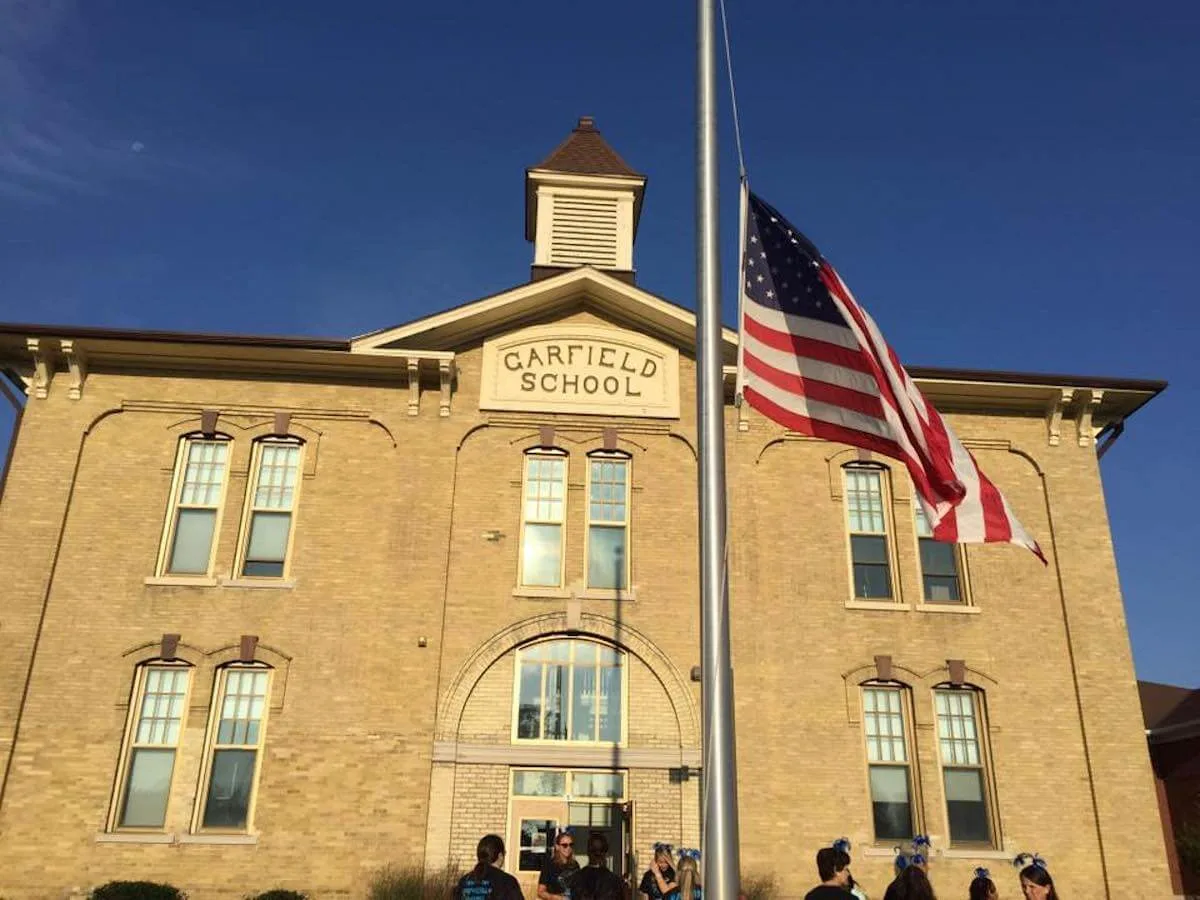
#image_title
Biden infrastructure plan meant to help districts where local voters may or may not approve critically needed repairs and staff to build a new generation of graduates.
To those who want President Joe Biden to limit his proposed infrastructure bill to roads and bridges but not school buildings and staff, educators ask that they walk a mile in their shoes each time they must seek voter approval through referendum to come up with much-needed funding.
Most recently, officials in 58 Wisconsin school districts eagerly watched the results of referendums in the April 6 election, many of them seeking voter approval to upgrade outdated learning spaces and infrastructure.
Some of the projects outlined in those 70 referendum questions–most notably a $148.8 million referendum seeking school additions, renovations and maintenance in the Wausau school district–involved major expenditures. Others, such as a proposed $1.825 million facilities and athletic fields upgrade in the Peshtigo school district, were far less costly but still needed, district officials said.
Whether Wisconsin school districts are able to upgrade facilities and continue programs depends on voters’ willingness to approve those projects. School leaders across the state say state infrastructure funding for the more than 400 public districts has lagged needed improvements for a couple of decades, leaving them no option but to ask residents to support paying for them through referendums.
“It’s gotten to the point where some districts plan to go to referendum every few years as part of their regular budget process,” said Kim Kaukl, executive director of the Wisconsin Rural Schools Alliance. “With the school funding situation what it is, they don’t really have any other choice.”
More than half of all school districts nationally report having outdated infrastructure needs, ranging from old school buildings, to insufficient heating and air-handling systems, to substandard technology systems.
That holds true in Wisconsin, school advocates say. The 2021 Report Card for American’s Infrastructure by the American Society of Civil Engineers shows needed infrastructure improvements in schools statewide total $836 million. Schools represent the second-largest public infrastructure category, after roads, the report states, but are often left out of infrastructure spending discussions.
Those school-related shortcomings in Wisconsin and elsewhere across the country would be addressed as part of Biden’s $2 trillion infrastructure proposal, the American Jobs Plan, that would modernize highways, roads, and bridges and would boost green energy initiatives while creating jobs and helping the economy recover from the coronavirus pandemic.
RELATED: Wisconsin’s Roads Need TLC and Lots Of Money. Biden’s Infrastructure Proposal Could Be a Lifeline.
The plan includes $100 billion for new school construction and improvements to existing school buildings. The proposal also includes $100 billion to expand broadband internet access, a measure that could boost such access for schools.
The plan would be funded by increasing the corporate tax rate to 28% and by boosting the minimum tax on multinational corporations in the US to 21%.
Whether those infrastructure improvements occur, and at what level, remains uncertain. Republicans in Congress are pushing back against the plan, saying it is too costly and includes provisions–including education funding–they don’t consider as direct infrastructure spending.
Wisconsin education advocates say Biden’s proposed infrastructure upgrades to schools would provide much-needed funding to address many past-due improvements. They say building and technology needs have become worse after years of underfunding for schools, and too many students learn in crowded or substandard settings.
“If schools are to be safe enough to continue to operate in person during a pandemic and beyond, these critical infrastructure problems must be addressed,” said Christina Brey, director of public affairs for the Wisconsin Education Association Council, the state’s largest teachers union. “This infrastructure funding could most definitely help schools, and Wisconsin, build back better after this pandemic.”
Educators in Milwaukee, Madison, and elsewhere across the state report students learning in crowded, classrooms in outdated buildings. In Racine and Milwaukee, the oldest school sites date to the Civil War era, they said. Brey said stories of collapsing ceilings, broken heating and air-conditioning systems, mold in schools and other structural shortcomings in Wisconsin schools have become commonplace.
With declining state funding for decades, local schools have only been able to address crumbling buildings and general maintenance projects such as roof repairs by going to referendum, she said. In districts where those referendums aren’t approved, those needs continue to grow.
Growing Need
Kaukl said the degree of infrastructure needs among Wisconsin schools can be gauged in part by the growing number of referendums in recent years seeking funding for those upgrades. Of the 70 on the ballot on April 6, 42 (60%) were approved. That figure was lower, at 53%, for the 36 referendums seeking voter approval for building projects.
Funding for building and technology improvements has become so scarce that some districts are holding referendums every couple of years to come up with enough money for upgrades, Kaukl said.
“For a lot of our rural districts referendums have become part of the budgeting cycle,” he said.
In the Wausau School District, voters shot down two referendum questions–a multifaceted building renovation and replacement proposal and another seeking to exceed spending caps by $3 million annually to retain staffing and programs–in November. Five months later district residents again denied the $148.8 million buildings project, but approved exceeding the state-imposed spending limit, this time by $4 million yearly.
Outgoing Wausau school board member Beth Martin said district officials are forced under the current funding structure to rely on voters to pass referendums for building projects and sometimes other expenditures as state funding continues to lag expenses. School districts can’t save for building repairs or replacements because the funding formula mandates that dollars be spent year to year.

Two of the Wausau district’s elementary schools, John Marshall and Grant schools, are nearly 100 years old and lack air conditioning. During her six years as a school board member, Martin said maintenance needs grew at schools districtwide.
“We get what the state gives us,” Martin said. “And for a long time, that hasn’t been enough to keep up with costs. So we have to go to referendum for projects and hope for the best. We’re between a rock and a hard place.”
The $148.8 million proposed in the April referendum included $54 million in deferred building maintenance costs, said Bob Tess, the district’s chief finance and business services officer. Many school districts unable to garner voter approval of maintenance referendums have run up significant past-due repair lists after years of building costs outpacing available funding, he said.
The Wausau district’s $1 million annual building maintenance budget has been frozen in recent years, Tess said. “It’s spread pretty thin when you have 20 buildings to maintain,” he said.
Badly outdated school buildings in the Racine School District prompted voters last year to approve a $1 billion referendum, part of which will be used to address facility needs. The district will spend that money–the largest school referendum in state history–through 2050.
Kaukl recalled struggling to keep old boilers operating during his years as a principal and district administrator, and dealing with other outdated building and technology concerns. School districts across the state are stretching their resources to keep schools functioning, he said, and that task has proven more difficult as time has progressed without increased funding.
“We’re going to hit the wall sooner or later with some of these buildings,” Kaukl said. “You can only defer maintenance for so long, and then you’re going to have these large expenses to upgrade rather than if you had been able to do it systematically over time.”
That has happened in some school districts already, said Christopher Thiel, legislative policy manager for Milwaukee Public Schools. Districts in which voters have not supported referendums have been forced to go without maintenance upgrades to ensure basic education services, he said, noting many schools in Milwaukee and elsewhere in the state are significantly outdated.
“In some situations in this state, we have 21st century kids in 19th-century buildings,” Thiel said.

Trump halts funding ‘Head Start.’ Baldwin says ‘not so fast.’
BAD NEWS 🗞️ Trump has halted more than $35 million in funding for Wisconsin “Head Start” centers — a 50% cut that could close preschools and child...

Banned Book of the Month: ‘Shine’ by Madison’s Lauren Myracle
More than 10,000 books were banned across America last school year, and Wisconsin is one of the worst offenders. At least 450 titles have been...

The 10 cheapest colleges in Wisconsin
Looking for an affordable way to continue your higher education without breaking the bank? Check out the 10 cheapest colleges in Wisconsin to get...

Why this lakefront Wisconsin school district is swimming with funding issues
Dozens of school districts across Wisconsin will once again go to referendum on April 1, asking for additional money from voters to help pay for...




